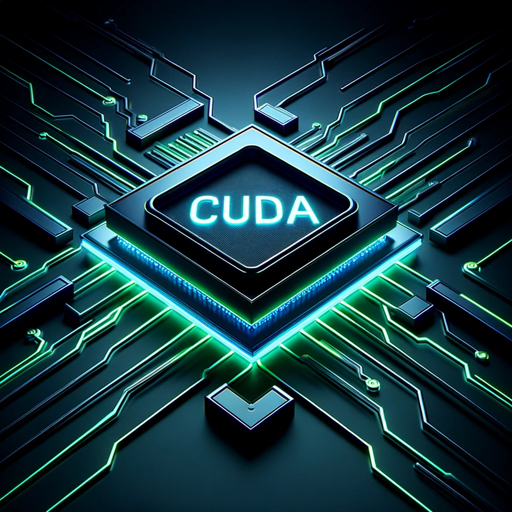GPU Crypto Mining-crypto mining profit calculator
AI-powered GPU crypto mining insights
What's the most profitable GPU for mining?
Show me the top coins for an RTX 3080.
Estimate profits for an AMD RX 580.
Generate an image of a GPU mining setup.
Related Tools
Load More
Crypto GPT
Expert in cryptocurrency info, analysis, and live prices

Crypto Trading GPT
Ultimate Guide For Beginners! 📚| 16 Crypto Trading Strategies | Crypto Trading Platforms | Crypto Wallets | Trending Cryptocurrencies | Live Prices | Crypto News | Ask anything! 🚀 [BETA]

CUDA GPT
Expert in CUDA for configuration, installation, troubleshooting, and programming.

CryptoGPT
Unearth hidden crypto gems with AI-driven analysis of low-cap coins poised for growth. Smart, insightful, your go-to for bullish potential

Semiconductor GPT
Explains the significance of semiconductors in AI.

Crypto Guru
A blockchain technology and cryptocurrency projects expert at your service.
20.0 / 5 (200 votes)
Introduction to GPU Crypto Mining
GPU crypto mining involves utilizing the parallel processing capabilities of Graphics Processing Units (GPUs) to solve complex mathematical puzzles that validate and secure transactions on blockchain networks. Unlike CPU mining, GPUs are specifically designed to handle large-scale, repetitive computations at a much faster rate. This makes them ideal for mining cryptocurrencies that rely on proof-of-work (PoW) consensus algorithms, such as Ethereum (before its transition to proof-of-stake), Ravencoin, and Ergo. For example, when mining Ethereum, a GPU solves cryptographic hash functions to find a valid block, which rewards the miner with a specified amount of Ether. These computational tasks involve rapidly performing billions of hashes per second, which GPUs can handle far more efficiently than standard CPUs due to their architecture. The mining process is energy-intensive, and profitability is determined by factors like hash rate (a measure of computational power), power consumption, and market conditions for the coin being mined. A detailed scenario includes using a GPU such as the NVIDIA RTX 3080 to mine Ravencoin by configuring a mining software (e.g., T-Rex Miner), connecting to a mining pool, and monitoring earnings on platforms like WhatToMine to evaluate profitability.

Key Functions of GPU Crypto Mining
Hash Rate Performance Calculation
Example
A miner uses an NVIDIA RTX 3090 to calculate the hash rate for mining Ethereum Classic. Based on the GPU's architecture, the mining software determines how many megahashes per second (MH/s) it can compute.
Scenario
In a real-world scenario, a miner calculates that their RTX 3090 produces 120 MH/s. They use this information on WhatToMine to estimate daily profits, taking into account electricity costs and current coin market value.
Mining Profitability Estimation
Example
Using platforms like WhatToMine, a user inputs details of their GPU (e.g., AMD RX 6800), power cost, and desired coin to mine (e.g., Ergo) to estimate daily or monthly profit.
Scenario
A home miner with an RX 6800 enters the GPU's hash rate (60 MH/s) and their electricity cost ($0.12/kWh) on WhatToMine. The site returns an estimated profit of $2.50 per day based on current Ergo prices.
Coin Selection for Mining
Example
A miner with multiple GPUs, such as an NVIDIA RTX 3070 and AMD RX 5700 XT, uses WhatToMine to decide whether to mine coins like Ravencoin, Flux, or Firo.
Scenario
In a scenario where Ethereum is no longer minable post-merge, the miner checks WhatToMine for the highest profitability and discovers that Ravencoin offers the best returns for their hardware configuration, considering the current network difficulty and rewards.
Ideal Users of GPU Crypto Mining Services
Individual Home Miners
These users typically run small to medium-sized mining rigs from their homes. They may own one or several GPUs and are highly focused on maximizing the profitability of their setup while minimizing costs like electricity. Home miners benefit from tools like WhatToMine for profitability tracking and from tailored mining software that optimizes hash rates based on their specific GPU configurations.
Mining Farm Operators
This group operates at a larger scale, often managing dozens or even hundreds of GPUs in data centers. Their focus is on maintaining a stable, optimized mining operation that balances electricity costs, cooling, and hardware performance. Mining farm operators rely on automated tools to monitor multiple GPUs, predict profitability across various coins, and ensure that the highest yielding coins are always mined. For example, farm operators might use WhatToMine to adjust mining strategies as market conditions fluctuate.

How to Use GPU Crypto Mining
Visit aichatonline.org for a free trial
Access the tool by visiting aichatonline.org. No login is required, and you do not need to have a ChatGPT Plus subscription to start using it.
Prepare Your Mining Hardware and Software
Ensure you have a compatible GPU, a stable internet connection, and the appropriate mining software such as PhoenixMiner, T-Rex Miner, or NBMiner.
Select the Coin and Mining Pool
Decide which cryptocurrency you want to mine (Ethereum, Ravencoin, etc.) and join a mining pool for better chances of earning rewards.
Optimize Your GPU Settings
Overclock your GPU and adjust power settings to maximize efficiency and profitability. Use tools like MSI Afterburner to tweak performance.
Monitor Mining Performance
Use tools such as WhatToMine to check profitability and ensure your system runs smoothly by monitoring GPU temperatures and hash rates.
Try other advanced and practical GPTs
CPP、GPU
AI-powered assistance for C++ and GPU

Home Expert
AI-powered assistance for smarter furniture shopping.

Pantone Color Finder
AI-powered precise Pantone color matching.

Word Smith
AI-powered writing enhancement.

Scholarship Finder
AI-powered tool for finding scholarships

Job Application Advisor
AI-powered job application perfection.

Wireframe Wizard
AI-powered Minimalistic Wireframes

Gaming Consoles Ultimate Buyers Guide
AI-powered gaming console recommendations at your fingertips.

Wireframe to Website
Turn wireframes into websites with AI

Wireframe Designer
AI-Powered Wireframe Creation Tool

Quick UX Wireframe
AI-powered tool for instant wireframes

Sigmond Wiresworth
AI-Powered Programmable Communications

- Performance Monitoring
- Hardware Setup
- Mining Efficiency
- Profitability Calculation
- Coin Selection
Top Questions About GPU Crypto Mining
What is GPU Crypto Mining?
GPU crypto mining is the process of using a Graphics Processing Unit (GPU) to solve complex mathematical problems, validate transactions, and add new blocks to a blockchain, in return for cryptocurrency rewards.
Which coins are best for GPU mining?
The most profitable coins for GPU mining vary based on current market conditions, but Ethereum (ETH), Ravencoin (RVN), and Ergo (ERG) are often top choices due to their higher profitability on GPUs.
How do I calculate the profitability of my GPU?
Use online tools like WhatToMine to input your GPU model, electricity cost, and other factors. This will help you estimate daily, weekly, or monthly profits based on current coin prices and difficulty levels.
What software is recommended for GPU mining?
Popular mining software includes PhoenixMiner, T-Rex Miner, NBMiner, and Gminer. These programs are optimized for different algorithms and offer features like dual mining, monitoring, and overclocking.
How can I reduce electricity costs while mining?
To reduce electricity consumption, underclock the power usage of your GPU, and mine during off-peak hours if possible. Additionally, use energy-efficient hardware and consider renewable energy sources if available.